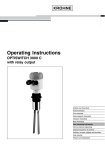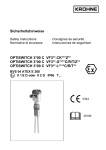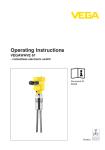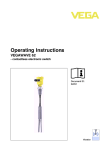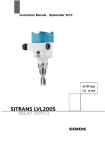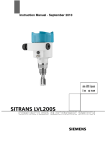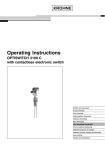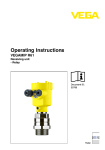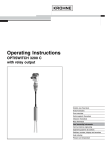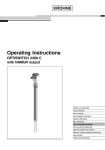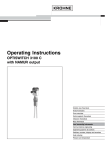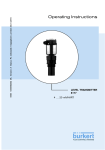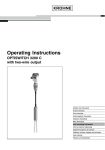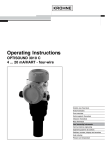Download Operating Instructions - OPTISWITCH 3000 C - with two-wire
Transcript
Operating Instructions OPTISWITCH 3000 C with two-wire output Contents Contents 1 About this document 1.1 1.2 1.3 2 . . . . . . . . . . . . . . . . . . . . . . . . . . . . . . . . . . . . . . . . . . . . .. .. .. .. 5 5 5 5 Configuration. . . . . . . Principle of operation . Operation . . . . . . . . . Storage and transport . . . . . . . . . . . . . . . . . . . . . . . . . . . . . . . . . . . . . . . . . . . . . . . . . . . . . . . . . . . . . . . . . . . . .. .. .. .. 6 6 7 7 General instructions. . . . . . . . . . . . . . . . . . . . . 9 Mounting instructions . . . . . . . . . . . . . . . . . . . . 10 Preparing the connection . . . . . . . . . . . . . . . . . 13 Connection steps. . . . . . . . . . . . . . . . . . . . . . . 13 Wiring plan, single chamber housing. . . . . . . . . 14 General. . . . . . . . . . . . . . . . . . . . . . . . . . . . . . 16 Adjustment elements . . . . . . . . . . . . . . . . . . . . 17 Function chart . . . . . . . . . . . . . . . . . . . . . . . . . 18 Maintenance . . . . . . . . . . Rectify faults . . . . . . . . . . Exchange the electronics . Instrument repair . . . . . . . . . . . . . . . . . . . . . . . . . . . . . . . . . . . . . . . . . . . . . . . . . . . . . . . . . . . . . . . .. .. .. .. 20 20 21 22 Technical data. . . . . . . . . . . . . . . . . . . . . . . . . 24 OPTISWITCH 3000 C - with two-wire output 30061-EN-060830 Dismounting procedure . . . . . . . . . . . . . . . . . . 23 Disposal . . . . . . . . . . . . . . . . . . . . . . . . . . . . . 23 Supplement 9.1 2 . . . . Dismounting 8.1 8.2 9 . . . . Maintenance and fault rectification 7.1 7.2 7.3 7.4 8 . . . . Set up 6.1 6.2 6.3 7 . . . . Connecting to voltage supply 5.1 5.2 5.3 6 . . . . Mounting 4.1 4.2 5 Authorised personnel . . Appropriate use. . . . . . Warning about misuse . CE conformity . . . . . . . Product description 3.1 3.2 3.3 3.4 4 4 4 4 For your safety 2.1 2.2 2.3 2.4 3 Function . . . . . . . . . . . . . . . . . . . . . . . . . . . . . Target group . . . . . . . . . . . . . . . . . . . . . . . . . . Symbolism used . . . . . . . . . . . . . . . . . . . . . . . Contents 9.2 9.3 Dimensions . . . . . . . . . . . . . . . . . . . . . . . . . . . 26 Certificates . . . . . . . . . . . . . . . . . . . . . . . . . . . 27 Supplementary operating instructions manuals Information: OPTISWITCH 3000 C is available in different versions. Depending on the selected version, supplementary operating instructions manuals may also come with the shipment. The supplementary operating instructions manuals are listed in section "Product description. 30061-EN-060830 Operating instructions manuals for accessories and replacement parts Tip: To ensure reliable setup and operation of your OPTISWITCH 3000 C, we offer accessories and replacement parts. The associated documents are: l Operating instructions manual "Oscillator" OPTISWITCH 3000 C - with two-wire output 3 About this document 1 About this document 1.1 Function This operating instructions manual has all the information you need for quick setup and safe operation. Please read this manual before you start setup. 1.2 Target group This operating instructions manual is directed to trained, qualified personnel. The contents of this manual should be made available to these personnel and put into practice by them. 1.3 Symbolism used Information, tip, note This symbol indicates helpful additional information. Caution: If this warning is ignored, faults or malfunctions can result. Warning: If this warning is ignored, injury to persons and/or serious damage to the instrument can result. Danger: If this warning is ignored, serious injury to persons and/or destruction of the instrument can result. Ex applications This symbol indicates special instructions for Ex applications. l List The dot set in front indicates a list with no implied sequence. à Action This arrow indicates a single action. 1 Sequence Numbers set in front indicate successive steps in a procedure. 30061-EN-060830 4 OPTISWITCH 3000 C - with two-wire output For your safety 2 For your safety 2.1 Authorised personnel All operations described in this operating instructions manual must be carried out only by trained specialist personnel authorised by the operator. For safety and warranty reasons, any internal work on the instruments must be carried out only by personnel authorised by the manufacturer. 2.2 Appropriate use OPTISWITCH 3000 C is a sensor for level detection. Detailed information on the application range of OPTISWITCH 3000 C is available in chapter "Product description". 2.3 Warning about misuse Inappropriate or incorrect use of the instrument can give rise to application-specific hazards, e.g. vessel overfill or damage to system components through incorrect mounting or adjustment. 2.4 General safety instructions OPTISWITCH 3000 C is a high-tech instrument requiring the strict observance of standard regulations and guidelines. The user must take note of the safety instructions in this operating instructions manual, the country-specific installation standards (e.g. the VDE regulations in Germany) as well as all prevailing safety regulations and accident prevention rules. 2.5 CE conformity OPTISWITCH 3000 C is in CE conformity with EMC (89/336/ EWG), fulfils NAMUR recommendation NE 21 and is in CE conformity with LVD (73/23/EWG). 30061-EN-060830 Conformity has been judged according to the following standards: l EMC: - Emission EN 61326: 1997 (class B) - Susceptibility EN 61326: 1997/A1:1998 l LVD: EN 61010-1: 2001 OPTISWITCH 3000 C - with two-wire output 5 Product description 3 Product description 3.1 Configuration Scope of delivery The scope of delivery encompasses: l l Components OPTISWITCH 3000 C level sensor Documentation - this operating instructions manual - Supplementary instructions manual "Plug connector for level sensors" (optional) OPTISWITCH 3000 C consists of the following components: l l l Housing cover Housing with electronics process fitting with tuning fork 1 2 3 Fig. 1 2 3 1: OPTISWITCH 3000 C with plastic housing Housing cover Housing with electronics Process fitting 3.2 Principle of operation Area of application OPTISWITCH 3000 C is a level sensor with tuning fork for level detection. It is designed for industrial use in all areas of process technology and is preferably used for bulk solids. It functions even when exposed to strong external vibration or changing products. 6 OPTISWITCH 3000 C - with two-wire output 30061-EN-060830 Typical applications are overfill and dry run protection. Thanks to its simple and robust measuring system, OPTISWITCH 3000 C is virtually unaffected by the chemical and physical properties of the bulk solid. Product description Fault monitoring The electronics of OPTISWITCH 3000 C continuously monitors the following criteria: l l Correct vibrating frequency Line break to the piezo drive If one of these faults is detected, the electronics signals this via a defined current to the signal conditioning instrument. The connection cable to the vibrating element is also monitored. Physical principle The tuning fork is piezoelectrically energised and vibrates at its mechanical resonance frequency of approx. 150 Hz. When the tuning fork is submerged in the product, the vibration amplitude changes. This change is detected by the integrated oscillator and converted into a switching command. Power supply Depending on your requirements, OPTISWITCH 3000 C with two-wire electronics can be connected to different signal conditioning instruments. Compatible signal conditioning instruments are listed under "Technical data". The exact range of the power supply is stated in the "Technical data" in the "Supplement". 3.3 Operation OPTISWITCH 3000 C can detect products with a density >0.08 g/cm³ (>0.003 lbs/in³). On the electronics module you will find the following indicating and adjustment elements: l l signal lamp for indication of the switching condition (green/ red) mode switch for selection of the output current 3.4 Storage and transport 30061-EN-060830 Packaging Your instrument was protected by packaging during transport. Its capacity to handle normal loads during transport is assured by a test according to DIN 55439. The packaging of standard instruments consists of environment-friendly, recyclable cardboard. In addition, the sensor is provided with a protective cover of cardboard. For special versions PE foam or PE foil is also used. Dispose of the packaging material via specialised recycling companies. OPTISWITCH 3000 C - with two-wire output 7 Product description Storage and transport temperature l l Storage and transport temperature see "Supplement Technical data - Ambient conditions" Relative humidity 20 … 85 % 30061-EN-060830 8 OPTISWITCH 3000 C - with two-wire output Mounting 4 Mounting 4.1 General instructions Switching point In general, OPTISWITCH 3000 C can be mounted in any position. The instrument must be mounted in such a way that the vibrating element is at the height of the requested switching point. Moisture Use the recommended cables (see chapter "Connecting to power supply") and tighten the cable gland. You can give your OPTISWITCH 3000 C additional protection against moisture penetration by leading the connection cable downward in front of the cable entry. Rain and condensation water can thus drain off. This applies mainly to mounting outdoors, in areas where moisture is expected (e.g. by cleaning processes) or on cooled or heated vessels. Fig. 2: Measures against moisture penetration Transport Do not hold OPTISWITCH 3000 C on the vibrating element. The sensor can be damaged by the weight of the instrument. Remove the protective cover just before mounting. 30061-EN-060830 Pressure/Vacuum The process fitting must be sealed if there is gauge or low pressure in the vessel. Before use, check if the seal material is resistant against the measured product and the process temperature. The max. permissible pressure is stated in the "Technical data" in the "Supplement" or on the type label of the sensor. Handling The vibrating level switch is a measuring instrument and must be treated accordingly. Bending the vibrating element will destroy the instrument. OPTISWITCH 3000 C - with two-wire output 9 Mounting Warning: The housing must not be used to screw in the instrument! Applying tightening force on the housing can damage its internal mechanical parts. To screw in, use the hexagon above the thread. 4.2 Mounting instructions Socket The vibrating element should protrude into the vessel to avoid buildup. For that reason, avoid using mounting bosses for flanges and screwed fittings. This applies particularly to use with adhesive products. Filling opening Mount the instrument in such a way that the tuning fork does not protrude directly into the filling stream. a. b. 20° Fig. 3: Horizontal mounting a Convex mounting b Concave mounting If such an installation location should be necessary, mount a suitable protective sheet above or in front of the vibrating element - see illustration a.). 10 OPTISWITCH 3000 C - with two-wire output 30061-EN-060830 In abrasive solids, mounting according to illustration b. has proven. A spout forms in the concave protective sheet preventing wear of the protective sheet. Mounting Horizontal mounting To achieve a very precise switching point, you can install OPTISWITCH 3000 C horizontally. However, if the switching point can have a tolerance of a few centimeters, we recommend mounting OPTISWITCH 3000 C approx. 20° inclined to the vessel bottom to avoid buildup. a. b. 20° Fig. 4: Horizontal mounting a Protective sheet b Concave protective sheet for abrasive solids If OPTISWITCH 3000 C is mounted in the filling stream, unwanted switching signals may be generated. Mount OPTISWITCH 3000 C at a location in the vessel where no disturbing influence from e.g. filling openings, agitators etc. can occur. Flows To minimise flow resistance caused by the tuning fork, OPTISWITCH 3000 C should be mounted in such a way that the surfaces of the blades are parallel to the product movement. 30061-EN-060830 Inflowing medium OPTISWITCH 3000 C - with two-wire output 11 Mounting 1 2 Fig. 5: Orientation of the tuning fork in case of flow 1 Marking with screwed version 2 Direction of flow Adhesive products In case of horizontal mounting in adhesive products, the surfaces of the tuning fork should be vertical in order to reduce buildup on the blades. On the screwed version you will find a marking on the hexagon. With this, you can check the position of the tuning fork when screwing it in. When the hexagon touches the seal, the thread can be still turned by approx. half a turn. This is sufficient to reach the recommended installation position. 1 Fig. 6: Vertical installation - marking 1 Marking on top with screwed version 30061-EN-060830 12 OPTISWITCH 3000 C - with two-wire output Connecting to voltage supply 5 Connecting to voltage supply 5.1 Preparing the connection Note safety instructions Generally not the following safety instructions: l Select power supply Connect only in the complete absence of line voltage Connect the power supply according to the following diagrams. Take note of the general installation regulations. As a rule, connect OPTISWITCH 3000 C to vessel ground (PA), or in case of plastic vessels, to the next ground potential. On the side of the instrument housing there is a ground terminal between the cable entries. This connection serves to drain off electrostatic charges. The data for power supply are stated in the "Technical data" in the "Supplement". Selecting the connection cable OPTISWITCH 3000 C is connected with standard cable with round cross section. An outer cable diameter of 5 ... 9 mm (0.2 ... 0.35 in) ensures the seal effect of the cable gland. If cable with a different diameter or wire cross section is used, exchange the seal or use an appropriate cable connection. 5.2 Connection steps 30061-EN-060830 Proceed as follows: 1 Unscrew the housing cover 2 Loosen compression nut of the cable entry 3 Remove approx. 10 cm (4 in) of the cable mantle, strip approx. 1 cm (0.4 in) insulation from the ends of the individual wires 4 Insert the cable into the sensor through the cable entry 5 Lift the opening levers of the terminals with a screwdriver (see following illustration) 6 Insert the wire ends into the open terminals according to the wiring plan 7 Press the opening lever of the terminals downward, you will hear the terminal spring closing 8 Check the hold of the wires in the terminals by lightly pulling on them 9 Tighten the compression nut of the cable entry, the seal ring must completely encircle the cable OPTISWITCH 3000 C - with two-wire output 13 Connecting to voltage supply 10 Screw the housing cover back on The electrical connection is hence finished. Fig. 7: Connection steps 5 and 6 5.3 Wiring plan, single chamber housing Electronics and connection compartment 1 4 3 2 14 8: Electronics and connection compartment DIL switch for mode adjustment Ground terminal Screwed terminals Control lamp OPTISWITCH 3000 C - with two-wire output 30061-EN-060830 Fig. 1 2 3 4 Connecting to voltage supply Wiring plan For connection to a signal conditioning instrument. The sensor is powered via the connected signal conditioning instrument. For further information see the "Technical data" in the "Supplement". The wiring example is applicable for all suitable signal conditioning instruments. If the mode switch of OPTISWITCH 3000 C is correctly set to "max.", the control lamp on OPTISWITCH 3000 C lights. l l red - with submerged vibrating element green - with uncovered vibrating element Take note of the operating instructions manual of the signal conditioning instrument. Suitable signal conditioning instruments are listed in the Technical data. 1 30061-EN-060830 Fig. 9: Wiring plan 1 Voltage supply OPTISWITCH 3000 C - with two-wire output 15 Set up 6 Set up 6.1 General The numbers in brackets refer to the following illustrations. Function/Configuration On the electronics module you will find the following indicating and adjustment elements: l l DIL switch for mode adjustment - min./max. (1) Signal lamp (4) Note: As a rule, always set the mode before starting the setup of OPTISWITCH 3000 C . If the instrument is used in conjunction with a signal conditioning instrument, always set the mode switch (1) on OPTISWITCH 3000 C to max. mode. The mode is selected on the signal conditioning instrument with the mode switch. The switching output will change if you set one of the two mode switches afterwards. This could possibly trigger other connected instruments or devices. 30061-EN-060830 16 OPTISWITCH 3000 C - with two-wire output Set up 6.2 Adjustment elements 4 1 3 2 Fig. 1 2 3 4 Mode adjustment (1) 10: Electronics module - Two-wire output DIL switch for mode adjustment Ground terminal Screwed terminals Control lamp With the mode adjustment (min./max.) you can determine the output current. When using a signal conditioning instrument, always set the mode switch to max. mode. In this case, you select the requested mode acc. to the "Function chart" (max. - max. detection or overfill protection, min. - min.detection or dry run detection) on the signal conditioning instrument. 30061-EN-060830 When used on a control system, the following values apply: Signal lamp (4) l Mode min. - Vibrating element uncovered - 16 mA ±1 mA - Vibrating element covered - 8 mA ±1 mA l Mode max. - Vibrating element uncovered - 8 mA ±1 mA - Vibrating element covered - 16 mA ±1 mA Control lamp for indication of the switching condition. l l l green = 8 mA red = 16 mA red (flashing) = Failure (<2.3 mA) OPTISWITCH 3000 C - with two-wire output 17 Set up 6.3 Function chart OPTISWITCH 3000 C level switch The following chart provides an overview of the switching conditions depending on the adjusted mode and level. Mode on the sensor Level Signal current - Sensor max. Overfill protection Signal lamp - sensor 8 mA Green max. Overfill protection approx. 16 mA min. Dry run protection approx. 8 mA min. Dry run protection approx. 16 mA red Green red Fault signal (min./max. mode) any <2.3 mA flashes red OPTISWITCH 3000 C level switch with signal conditioning instrument1) The following chart provides an overview of the switching conditions depending on the adjusted mode of the signal conditioning instrument and the level. Note: Keep in mind that the mode switch of OPTISWITCH 3000 C must be always set to "max.". 18 You will find suitable signal conditioning instruments under "Technical data" OPTISWITCH 3000 C - with two-wire output 30061-EN-060830 1) Set up Mode on the signal conditioning instrument Level Signal current Sensor Mode A Overfill protection Signal lamp - sensor Signal lamp - signal conditioning instrument approx. 8 mA Green Mode A Overfill protection approx. 16 mA red Mode B Dry run protection approx. 16 mA Mode B Dry run protection approx. 8 mA red Green Fault signal (mode A/B) any <2.3 mA 30061-EN-060830 flashes red OPTISWITCH 3000 C - with two-wire output 19 Maintenance and fault rectification 7 Maintenance and fault rectification 7.1 Maintenance When used as directed in normal operation, OPTISWITCH 3000 C is completely maintenance free. 7.2 Rectify faults Causes of malfunction OPTISWITCH 3000 C offers maximum reliability. Nevertheless faults can occur during operation. These may be caused by the following, e.g.: l l l l Sensor Process Power supply Signal processing Fault rectification The first measure to be taken is to check the output signal. In many cases, the causes can be determined this way and the faults rectified. Checking the switching signal ? OPTISWITCH 3000 C signals "covered" when the vibrating element is not submerged (overfill protection) ? OPTISWITCH 3000 C signals "uncovered" when the vibrating element is submerged (dry run protection) l Supply voltage too low à Check the power supply l Electronics defective à Press the mode switch (min./max.). If the instrument then changes the mode, the instrument may be mechanically damaged. Should the switching function in the correct mode still be faulty, return the instrument for repair. à Push the mode switch. If the instrument then does not change the mode, the oscillator may be defective. Exchange the oscillator. à Check if there is buildup on the vibrating element, and if so, remove it. l Unfavourable installation location no dead zones or mounds can form. à Check if the vibrating element is covered by buildup on the socket. 20 OPTISWITCH 3000 C - with two-wire output 30061-EN-060830 à Mount the instrument at a location in the vessel where Maintenance and fault rectification l Wrong mode selected à Set the mode switch on OPTISWITCH 3000 C to "max". Set the correct mode on the signal conditioning instrument (A: overfill protection; B: dry run protection). ? Signal lamp flashes red l Electronics has detected a failure à Exchange instrument or return instrument for repair 7.3 Exchange the electronics In general, all oscillators of series VB60 can be interchanged. If you want to use an oscillator with a different signal output, you can download the corresponding operating instructions manual from our homepage under Downloads. Proceed as follows: 1 Switch off power supply 2 Unscrew the housing cover 3 Lift the opening levers of the terminals with a screwdriver 4 Pull the connection cables out of the terminals 5 Loosen the two screws with a Phillips screwdriver (size 1) 1 2 30061-EN-060830 Fig. 11: Loosen the screws 1 Electronics module 2 Screws (2 pcs.) 6 Remove the old oscillator 7 Compare the new oscillator with the old one. The type label of the oscillator must correspond to that of the old oscillator. OPTISWITCH 3000 C - with two-wire output 21 Maintenance and fault rectification 8 Compare the settings of the two oscillators. Set the adjustment elements of the new oscillator to the same setting of the old one. Information: Make sure that the housing is not rotated during the electronics exchange. Otherwise the plug may be in a different position later. 9 Insert the oscillator carefully. Make sure that the plug is in the correct position. 10 Screw in and tighten the two screws with a Phillips screwdriver. 11 Insert the wire ends into the open terminals according to the wiring plan 12 Press the opening lever of the terminals downward, you will hear the terminal spring closing 13 Check the hold of the wires in the terminals by lightly pulling on them 14 Check the tightness of the cable entry. The seal ring must completely encircle the cable. 15 Screw the housing cover back on The electronics exchange is hence terminated. 7.4 Instrument repair If a repair is necessary, please proceed as follows: You can download a return form from our website http://www. krohne-mar.com/fileadmin/media-lounge/PDF-Download/ Specimen_e.pdf. By doing this you help us carry out the repair quickly and without having to call back for needed information. l l l Print and fill out one form per instrument Clean the instrument and pack it damage-proof Attach the completed form and possibly also a safety data sheet to the instrument 30061-EN-060830 22 OPTISWITCH 3000 C - with two-wire output Dismounting 8 Dismounting 8.1 Dismounting procedure Warning: Before dismounting, be aware of dangerous process conditions such as e.g. pressure in the vessel, high temperatures, corrosive or toxic products etc. Take note of chapters "Mounting" and "Connecting to power supply" and carry out the listed steps in reverse order. 8.2 Disposal The instrument consists of materials which can be recycled by specialised recycling companies. We use recyclable materials and have designed the electronic modules to be easily separable. WEEE directive 2002/96/EG This instrument is not subject to the WEEE directive 2002/96/ EG and the respective national laws (in Germany, e.g. ElektroG). Pass the instrument directly on to a specialised recycling company and do not use the municipal collecting points. These may be used only for privately used products according to the WEEE directive. Correct disposal avoids negative effects to persons and environment and ensures recycling of useful raw materials. Materials: see "Technical data" 30061-EN-060830 If you cannot dispose of the instrument properly, please contact us about disposal methods or return. OPTISWITCH 3000 C - with two-wire output 23 Supplement 9 Supplement 9.1 Technical data General data Material 316L corresponds to 1.4404 or 1.4435 Materials, wetted parts - Process fitting - thread plastic PBT (Polyester) - Process seal - Thread Klingersil C-4400 - Tuning fork 316L Materials, non-wetted parts - Housing plastic PBT (Polyester) - Seal ring between housing and housing cover silicone - Ground terminal 316L Weight 1500 g (53 oz) Max. lateral load 600 N (135 lbf) longitudinal to the fork side Output variable Output Two-wire output Suitable signal conditioning instrument SU 501 Ex Output signal - Mode min. Vibrating element uncovered - 16 mA ±1 mA Vibrating element covered - 8 mA ±1 mA - Mode max. - Fault signal <2.3 mA Modes (adjustable) min./max. Integration time - when immersed approx. 0.5 s - approx. 1 s when laid bare Vibrating element uncovered - 8 mA ±1 mA Vibrating element covered - 16 mA ±1 mA Ambient conditions -40 … +80 °C (-40 … +176 °F) Storage and transport temperature -40 … +80 °C (-40 … +176 °F) 24 OPTISWITCH 3000 C - with two-wire output 30061-EN-060830 Ambient temperature on the housing Supplement Process conditions Parameter Limit level of solids Process pressure -1 … 6 bar/-100 … 600 kPa (-14.5 … 87 psi) Process temperature -50 … +100 °C (-58 … +212 °F) Density >0.08 g/cm³ (0.003 lbs/in³) Electromechanical data Cable entry/plug2) - Single chamber housing l or: l 1x cable entry M20x1.5 (cable-ø 5 … 9 mm), 1x blind stopper M20x1.5 1x closing cap ½ NPT, 1x blind plug ½ NPT or: l Spring-loaded terminals 1x plug (depending on the version), 1x blind plug M20x1.5 for wire cross-section up to 1.5 mm² (0.0023 in²) Adjustment elements Mode switch - min. Min. detection or dry run protection - Max. detection or overfill protection max. Voltage supply Supply voltage 10 … 36 V DC (via the signal conditioning instrument) 30061-EN-060830 Electrical protective measures Protection IP 66/IP 67 Overvoltage category III Protection class II 2) Depending on the version M12x1, according to DIN 43650, Harting, Amphenol-Tuchel, 7/8" FF. OPTISWITCH 3000 C - with two-wire output 25 Supplement 9.2 Dimensions 22mm (55/64") 30,4mm (1 13/64") OPTISWITCH 3000 C G1½A 220,5mm (8 11/16") 150mm (5 29/32") ø 43mm (1 11/16") Fig. 12: OPTISWITCH 3000 C, threaded version G1½ A 30061-EN-060830 26 OPTISWITCH 3000 C - with two-wire output Supplement 9.3 Certificates 30061-EN-060830 CE declarations of conformity Fig. 13: CE declarations of conformity OPTISWITCH 3000 C - with two-wire output 27 Supplement Manufacturer declaration 28 30061-EN-060830 Fig. 14: Manufacturer declaration OPTISWITCH 3000 C - with two-wire output 30061-EN-060830 Supplement OPTISWITCH 3000 C - with two-wire output 29 Supplement 30061-EN-060830 30 OPTISWITCH 3000 C - with two-wire output 30061-EN-060830 Supplement OPTISWITCH 3000 C - with two-wire output 31 Subject to change without notice 30061-EN-060830

































